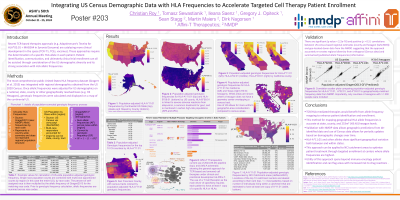Back

Integrating US Census Demographic Data with HLA Frequencies to Accelerate Targeted Cell Therapy Patient Enrollment
(P203) Integrating US census demographic data with HLA frequencies to accelerate targeted cell therapy patient enrollment
Location: Platinum Ballroom

Poster Presenter(s)
Aim: Recent TCR-based therapies approvals have stimulated additional clinical development (TCR-T's, TCEs, vaccines). These therapies require the determination of a specific HLA allele in each patient. Patient identification, communication, and ultimately clinical trial enrollment could all be assisted through consideration of the US demographic diversity and its strong association with HLA allelic frequencies.
Method: We integrated the most comprehensive public United States HLA frequency dataset (Gragert et al. 2013) with regional demographics obtained from the US 2020 Census. Once allelic frequencies were adjusted for US demographics on a national, state, or county-wide basis, genotypic frequencies were calculated and displayed on a map of the continental US.
Results: Here we show regional US State and County HLA frequencies for five HLA-A alleles which are—or maybe—used in TCR-based therapies. These maps underscore the diverse distribution of HLA frequencies when adjusted for demographics. For example, across states HLA-A*11:01 genotypic frequency ranges between 10–15% (US average 11.3%), with west coast states like California and Washington having the highest HLA-A*11:01 frequencies, meaning that 1.5 times as many patients could be eligible in certain states compared to others. Moreover, substantial differences are observed within states on the county level. In California HLA-A*11:01 frequency ranges between 10–19%, which is almost a 2-fold difference. Furthermore, we confirmed that there are significant (p value < 2.2e-16) and positive (r > 0.5 ) correlations between US-census based regional estimates and geo-located donor data from the National Marrow Donor Program suggesting that the approach accurately re-creates regional diversity from orthogonal (Census Data) and summarized (published allelic frequencies) information.
Conclusion: As more HLA/peptide targeting TCR-based therapies undergo clinical development, integration of comprehensive genetic profiling with HLA-typing will become critical gating criteria for efficient patient selection and enrollment. While many other factors play a role in clinical development, knowledge of patient HLA frequencies proximal to clinical trial sites could help in site prioritization and other drug development efforts including boosting eligible patients and identifying trial sites which may benefit from increased HLA typing capabilities.
Method: We integrated the most comprehensive public United States HLA frequency dataset (Gragert et al. 2013) with regional demographics obtained from the US 2020 Census. Once allelic frequencies were adjusted for US demographics on a national, state, or county-wide basis, genotypic frequencies were calculated and displayed on a map of the continental US.
Results: Here we show regional US State and County HLA frequencies for five HLA-A alleles which are—or maybe—used in TCR-based therapies. These maps underscore the diverse distribution of HLA frequencies when adjusted for demographics. For example, across states HLA-A*11:01 genotypic frequency ranges between 10–15% (US average 11.3%), with west coast states like California and Washington having the highest HLA-A*11:01 frequencies, meaning that 1.5 times as many patients could be eligible in certain states compared to others. Moreover, substantial differences are observed within states on the county level. In California HLA-A*11:01 frequency ranges between 10–19%, which is almost a 2-fold difference. Furthermore, we confirmed that there are significant (p value < 2.2e-16) and positive (r > 0.5 ) correlations between US-census based regional estimates and geo-located donor data from the National Marrow Donor Program suggesting that the approach accurately re-creates regional diversity from orthogonal (Census Data) and summarized (published allelic frequencies) information.
Conclusion: As more HLA/peptide targeting TCR-based therapies undergo clinical development, integration of comprehensive genetic profiling with HLA-typing will become critical gating criteria for efficient patient selection and enrollment. While many other factors play a role in clinical development, knowledge of patient HLA frequencies proximal to clinical trial sites could help in site prioritization and other drug development efforts including boosting eligible patients and identifying trial sites which may benefit from increased HLA typing capabilities.

